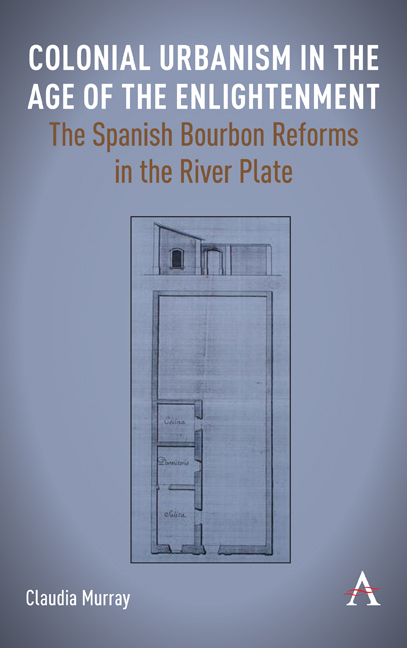Book contents
- Frontmatter
- Contents
- List of Figures and Tables
- Acknowledgements
- Introduction
- 1 The Spanish Empire Before the Bourbon Reforms
- 2 The River Plate Before 1776 and the Bourbon Reforms
- 3 Urban Expansion
- 4 The Image of Power
- 5 Ceremonies of Power
- 6 Disciplining Porteños’ Private Architecture
- 7 The British Assault on the River Plate
- Appendix 1
- Bibliography
- Index
2 - The River Plate Before 1776 and the Bourbon Reforms
Published online by Cambridge University Press: 28 February 2024
- Frontmatter
- Contents
- List of Figures and Tables
- Acknowledgements
- Introduction
- 1 The Spanish Empire Before the Bourbon Reforms
- 2 The River Plate Before 1776 and the Bourbon Reforms
- 3 Urban Expansion
- 4 The Image of Power
- 5 Ceremonies of Power
- 6 Disciplining Porteños’ Private Architecture
- 7 The British Assault on the River Plate
- Appendix 1
- Bibliography
- Index
Summary
The Foundation of Buenos Aires
The Spanish Pedro de Mendoza (1487–1537) founded the port called Nuestra Señora Santa María del Buen Ayre on 2 February 1536. The settlement was the result of various Spanish expeditions searching for a passage connecting the Atlantic and Pacific oceans, a connection of strategic importance given the possibilities of shortening trading routes and the discovery of new lands. Juan Diaz de Solis (1470–1516) commanded the first expedition in 1512; the voyage had such tactical significance that it was secretly organised to avoid leaking information to foreign sailors and nations. The result was the European exploration of the River Plate and the Paraná River, and although Solis died during a defence of the territory mounted by local indigenous groups, the area soon attracted the attention of other sailors.
The second expedition was that of Ferdinand Magellan (1480–1521), a Portuguese at the Spanish service, who sailed down the River Plate in 1520 but left the area when he realised that the river did not provide a passage to the Pacific, continuing the journey south and eventually succeeding in his quest. The importance of these expeditions is not only the success in finding a connection between the two oceans, but also the new knowledge that was gathered and shared in the attempts. By pushing the Spanish's boundaries further south, the River Plate area begun appearing in European maps, particularly as survivors of the expeditions recounted the stories of a legendary king with enormous wealth, known as the White King. Indeed, port taverns and bars were the perfect place to exchange travelling stories. The English Sebastian Cabot (1474–1557), who was also at the service of the Spanish king, heard the story of the White King while docked in Pernambuco (today Brazil), deciding immediately to set sail south in search for the treasure in 1526. The expedition was unsuccessful, although it resulted in the foundation of the fort of Sancti Spiritus, the first settlement in today's Argentinean territory. However, the colony did not last long as it was soon destroyed by local indigenous groups who were defending their territories. Cabot returned demoralised to Spain, where he nevertheless spread the legend of the White King that captivated the imagination of other Spaniards.
- Type
- Chapter
- Information
- Colonial Urbanism in the Age of the EnlightenmentThe Spanish Bourbon Reforms in the River Plate, pp. 23 - 52Publisher: Anthem PressPrint publication year: 2023



